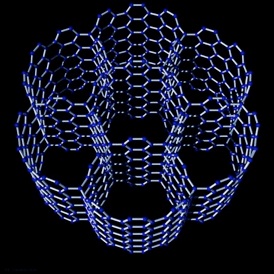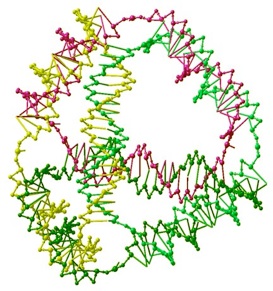NANOARCHITECTURE A DISCOURSE PART I
© John M Johansen All Rights Reserved
NANOARCHITECTURE A DISCOURSE PART I
© John M Johansen All Rights Reserved
MORPHABILITY
Nanobots will produce clear sheets of diamond, a few millimeters thick, to form the exterior membrane of a building. These membranes could be opaque, or by electro-molecular realignment, they could become translucent or transparent. Such astonishing versatility within the molecular product is termed "morphability" - one of the quintessential aspects of MNT. Empowered by millions of controlled nanomotors, the artifact easily alters its characteristics.
Protective membranes regulate light and air and act as the building insulator. In warmer weather, the molecules respond by collapsing tightly, exhausting the air; for increased insulation the molecules expand into a thick foam with innumerable closed air spaces.
Accordingly, Drexler proposes that artificial DNA, or coding devices, be developed and employed in structuring matter to the service of mankind.
Within the molecular structure, atoms of various chemical make-ups are selected, assembled in particular patterns, and programmed to replicate themselves thus enabling immense workforces to produce products of almost any design. The molecular structure harnesses the energies from chemicals and electricity, rather than conventional human labor and current major power sources.
Progress to Date
Notable advances have been made in the allied field of biochemistry. Genetic engineers have programmed bacteria to make proteins used in human growth hormone and insulin. In the field of computer-aided design, the National Science Foundation has supported research for developing molecular computers, and the Japanese government has launched a program to develop microscopic, self-assembling molecular motors. These instruments are essential elements in the nanotechnological enterprise.
At the forefront of research and development are the Palo Alto-based Foresight Institute and its affiliate, the Institute of Molecular Manufacturing, which were formed specifically to develop molecular assembler-robots programmed to build. The Nanotechnology Development Corporation of NASA has also invested extensively in the research of MNT and its applications for construction in space. Though a self-assembling molecule has yet to be produced, its development seems inevitable.
This research has lead scientists to develop products based on MNT for future consumption by ordinary people. At the Ames laboratory at NASA, J. Storrs Hall has designed a simulated “Air Car" that can be controlled remotely and with little human input; Hall's "Air Car" is designed specifically to prompt further experimentation in aeronautics.
Implications for the Future
The implications of this new technology are vast. As Kai Wu has written: "Imagine a technology so powerful that it will allow such feats as desktop manufacturing, cellular repair, artificial intelligence, inexpensive space travel, clean abundant energy, environmental restoration; a technology so portable that everyone can reap its benefits - which will radically change our economic and political systems - and so imminent that most of us will see its impact within our lifetimes.

Nanotechnology will soon change industrial production by introducing labor-free manufacturing. This will directly influence our health, welfare, comfort, and prosperity. The molecular assembler breakthrough will transform our entire manufacturing process; for this, we must prepare. As with previous technological revolutions, MNT will present new ways of thinking about society and ourselves, and exact the same moral responsibilities.
Feasibility
Time, as a factor of molecular growth, is of crucial importance. The slow pace of cellular growth in nature is not comparable to the demands of modern manufacturing, marketing, and consumption. However, it is predicted that artificial growth by MNT will greatly outpace both that of nature and present manufacturing. Drexler remarks that with MNT, "a vast number of replicators will produce assemblers by the ton," which will in turn allow for rapid production. The replicators, when grouped in what theorist Ralph Merkle has called a "Convergent Assembly," form molecular building parts, or "bricks," that can be assembled into larger parts. Groups of these could then be assembled into still larger parts. Within a few minutes, a thirty stage convergent assembly could produce a final product of one meter from material initially one manometer in size.
Another consideration is cost. Merkle states, "Common elements like hydrogen, carbon, nitrogen, oxygen, aluminum, and silicone are best sources for constituting the bulk of most structures, and because these elements can be taken in abundance from earth, water, and air, raw materials will be dirt cheap." The cost of molecular engineering - minus licensing fees, insurance, and business expenses - is comparable to the cost of creating plastic or industrial chemicals. Labor constitutes a minor factor within MNT; excepting costs for the development of computer software, MNT is labor-free.
Drexler continues, "it seems that the feasibility of nanotechnology and molecular assemblers is to be taken seriously -- for one, existing molecular machines already serve us as basic functions, and two, that parts serving these basic functions can be combined to build complex machines--since chemical reactions can bond atoms together in diverse ways, and molecular machines can direct chemical reactions according to programmed instructions." He adds that "assemblers are definitely feasible. It may take some years for the assemblers to emerge, but their emergence seems almost inevitable."
Coding
Artificial DNA, or coding, is essential to the process of molecular nanotechnology. If molecular structures are to reproduce and build products, they must be given directions as to what to build, how, when, and where. "It is important to know that molecular assemblers cannot build anything by themselves," writes Bill Spence. "All products familiar today and inventions of future products to be built by MNT must be re-designed, engineered, molecularly modeled ...and translated into functional software."
It is possible, at this time, to transfer the exact pattern of DNA to an artificial code. Architect-morphologist Haresh Lavani states, "Coupled with biological (DNA based) or other (chemical-physical) building processes, the artificial genetic code enables, growth, adaptation, evolution, and replication of buildings permitting architecture to design itself." Regarding evolution, recent research by Lipson and Prilock of Brandeis University's Deno-Lab has revealed that robot evolution is close to realization.They have designed robots that reproduce according to performance, simulating natural selection and the process of evolution in nature.
In his book, An Evolutionary Architecture, the British computer technician and visionary John Frazier states that "our description of an architectural concept encoded is analogous to the genetic code DNA script in nature -- we go beyond present blueprints and specifications to a coded set of genetic instructions called a 'genetic language of Architecture.’” He describes his project, Universal Constructor (1990), as a "tool for the explanation and demonstration of a radically new design process." Certain buildings familiar to us have already been coded as to schema, plan, section, mass, dimension, material, detail, and construction strategy. Newly designed building concepts can be easily coded as well.
Molecular Building Process
The molecular building process is not biological, but mechanical; living cells are replicated by dividing, assemblers replicate mechanically, by building others. As Drexler has written: "The great difference is that nanotech use not living ribosomes but robotic assemblers, not veins but conveyor belts, not muscles but motors, nor genes but computers, not cells dividing but small factories producing products and additional factories."
Assemblers are robots, or "nanobots," with communicative powers that in collaboration can build anything they are programmed to build. They are organized by their "foreman," the seed computer, into specialized building crafts that operate as part of a vast construction project. Mechanical assemblers are expected to employ a greater variety of tools and use them with greater force, control, and precision than ribosomes can in nature.









Growth at the Building Site
The notion of growing architecture was proposed in 1961 by Katavolos, and expanded by Vittorio Giorgini, in “Early Experiments in Architecture Using Natures Building Technology," in 1997. However, only recently have we come to understand the specifics of molecular growth. The process begins as the hardy molecules position their roots in the vats. Growth emerges, growing upward and outward as their code directs. For larger, out-of-vat products, growth is dependent on the linear, vertical delivery of nourishment. It is noted that "large plants and animals have 'vascular systems' and intricate channels to carry materials to molecular machinery working through their systems. In similar fashion, artificial assembly systems could also employ this strategy ... to build a scaffold, then working through its volume incorporating materials from the central source, in this case, the vat."
Vat growth may be described through the process of "accretion," with atoms adhering to a base-as rock candy is the crystallization of liquid sugar adhering to a stick or string. For growth out of vat, at the scale of a building, there must be a linear or directional growth pattern: root, stem, rib, lattice or branches, nourished by a "fibro-vascular" distribution.
There are numerous questions that an experimental architect like myself would ask when confronted by a new building technology such as this. How will this building method aid in designing better buildings? What alternatives will it provide? What are its potentials and limitations? What defines its character? How will this molecular growth process express itself?
Environmental Considerations
The "seed," of coding device, will replace conventional blueprints, specifications, and construction procedures. In regard to ecological relationships, the seed contains instructions with feedback allowing the new building to respond to its immediate surroundings. So far, the most extraordinary proposal put forth is that of coordinating the artificial coding of a building with the DNA of a living environment. That is to say, the building would be programmed to monitor its environment and adjust or alter its design so as to be in harmony, or symbiotic relationship, with nature.
Frazier addresses the emerging field of "architectural genesis.' He approaches coding for architecture at a far more advanced state than I have discussed. The building as artifact is designed to interact and evolve with natural forces. Frazier offers, "a new, computer-based technology for developing design models, not in physical form at this stage, but rather of inner logic." He continues, “Our computer model will be the expression of the equilibrium between the androgynous development of the architectural concept and the exogenous influences exerted by the environment." These buildings may be considered self-organizing. Such buildings, he states, "will maintain stability by negative feedback interactions and promote their evolution in their employment of positive feedback." The building knows its coding for development, and in this sense, can be considered an organism of artificial life and intelligence. Frazier envisions architecture developed to this state as "literally part of nature, in which manmade and natural environments are to be considered each as parts of a global ecosystem." Frazier's projections leave us with a view of how mankind may, if guided by its higher instincts and moral principles, reestablish a citizenry in resonance with the ecosystem.

Website Copyright © 2011 John M Johansen All Rights Reserved
No information, photos, videos or audio on this website may be distributed, copied
or otherwise used without the written permission of John M Johansen or his representative
Website created by John Veltri and Marguerite Lorimer EarthAlive Communications www.earthalive.com
Please direct inquires to info@earthalive.com


John M Johansen discussing nanoarchitecture with Richard Rogers, November 2010. Click on photo for more.

Design Your Own Materials
It is expected that a new substance, known as diamond and constructed of all carbon nanotubes made of the highest molecular density and bonding power, will be fifty times the strength of steel and lighter in weight. Diamond's extraordinary clarity and strength will make it an ideal building material that will, as produced by nanobots, conform to any shape. Diamond substances, consisting of readily available carbon, will be as inexpensive as glass. Structural elements will vary from extremely dense to porous and lightweight readily responding to the extreme stresses on heavy machinery, vehicles, or even buildings. Such large carbon structures of architectural scale will assume an appearance of transparency. Strangely new, these qualities made possible by nanotechnology create an intriguing paradox: a lightweight, invisible structure that has tremendous strength.
Physicist K. Eric Drexler, considered the founding father of nanotechnology, has advanced realistic procedures for designing simulated molecular structures.
The New Species of Architecture: Nanoarchitecture. Click on photo to go to Molecular Engineered House
We will look back upon present day structural steel assemblies and connections of milled parts, bolted and welded, as not only grossly inefficient and costly, but ludicrous. Molecular growth process will replace the abrupt joints and edges of contemporary construction with imperceptible transitions from one specialized substance to another, as bone tissue to ligament to muscle to skin. Structure will be integral with the building shell, walls, and enclosure, and building materials will be seamlessly fused in a completely unified entity.
Looking back from the future, our present buildings will seem quaint. As we anticipate such buildings of strength, lightness, integral structure, seamless continuity of surface, transparency, and evolving, growing forms, molecular nanotechnology will reshape the man-made environment. These new characteristics explain how the molecular growth process, subject to architectural design orchestration, will insist, in its own right, to express itself.
The preceding discourse, from Nanoarchitecture: A New Species of Architecture by John M Johansen FAIA published by Princeton Architectural Press, is protected by copyright © John M Johansen All Rights Reserved. This information may not be copied, reproduced or used in any way without written permission from John M Johansen FAIA or his representative.
Detail of molecular-engineered Multistory Apartment Building; click on photo to go to Theoretical Architecture
From the outset, it should be understood that molecular-engineered buildings are still theoretical in nature. Though the projects that I have developed over the past decade are indeed based upon technologies that, before long, will be realized, the applications of molecular engineering, architectural included, remain speculative.
Molecular Nanotechnology (MNT) represents a new phase in the evolution of manmade structures. The central thesis that nanotechnology is "capable of producing almost any chemically stable structure that can be specified" was first advanced by the physicist Richard Feynman in 1945. Prompted by Feynman, physicist-designer William Katavolos expanded the study of MNT to the growth of architecture, foreseeing the production of a large floating city. Katavolos remarks, "We are rapidly gaining the necessary knowledge of the molecular structure of these chemicals with the necessary techniques that will lead to the productions of materials that will have a specific program of behavior built into them."
Advanced studies link the processes of DNA with molecular growth. James Watson and Francis Crick discovered that DNA governs the continuity and growth of all living things.



















Further advantages of morphable substances include such applications as interior room partitioning and adjustable, self-adaptive furniture that responds to position, attitude, and comfort requirements. J. Storrs Hall has developed "Utility Fog" - a linked mechanism that transforms an object into any shape. If one surfaces a floor with a layer of "Fog," furniture could extrude or dissolve into various forms or styles. Likewise, if interior walls are surfaced with "Fog," partition, layout, decor-the entire domestic environment could be changed at will.
Investigations into kinetics suggest structural elements that may be jointed or pivoted. Studies of animal forms indicate how they evolve as moving parts. These characteristics may be evident in our buildings as transformations, extensions, retractions, self-folding, unfolding, even self locomotion. Hall's "Air Car" is designed to have self-extending legs, while its wings adjust in shape and attitude for maximum performance at various speeds. With all the versatility of these substances, objects now familiar to us will appear new. Architects will indeed be presented with rather different design factors.
Architectural Expression
The word “growth" is extensively used in the field of MNT, and is accepted not just as an analogy to nature, but rather as an artificial reenactment of natural growth processes. It is altogether reasonable, therefore, to adopt "growth" as a basis for architectural expression.
Throughout the history of architecture, formal expression has derived from methods of construction. Molecular growth will bring us back to natural form. This is not stylization, biomorphism, or representation. Natural structuring or branch systems establish optimal strength-to-weight ratios. Molecular-engineered buildings are expected to be 10 percent as massive as buildings today, resulting in entirely new systems of structuring and radically different forms.
